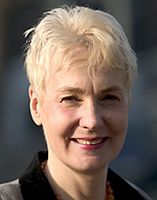Baker, A.E.

Anne Baker, born in Bournemouth, UK, in 1948. D.Habil. from the Universität Tübingen and Ph.D. from the University of York. Professor of General Linguistics at the University of Amsterdam.
Fellow (1 September 2005 – 31 January 2006)
WHAT THE DEVELOPMENT OF BIMODAL SYSTEMS IN CHILDREN LEARNING A SIGN LANGUAGE CAN TELL US ABOUT THE EMERGENCE OF LANGUAGE
Some earlier research has posited that the visual-spatial modality is more accessible for communication as it is acquired earlier than the oral-aural modality (Newport & Meier; 1985 Petitto & Marntette 1991). This in turn has been interpreted as the visual-spatial modality being earlier in phylogenetic terms. Would ontogenetically earlier development in the motor skills needed to sign necessarily mean that this was the modality in which language developed phylogenetically? A different window on this question is whether the simultaneous production of speech and sign or vocalizations and hand movements in young infants shows an internal temporal structure related to modality. Do infants who are exposed to both a sign language and a spoken language by their deaf parents show a temporal dominance of the one or other modality in that simultaneous combinations always begin in one modality? If this is the case, for both deaf and hearing infants of deaf parents, it might suggest that the one modality leads and frames the other. Data were taken from three hearing children and three deaf children of deaf signing parents between nine months and two years (database UvA). The analysis is made from a restricted time sample of mouth movements and hand movements not in combination and all types of combinations in both the child’s production and the deaf mother’s production (input).
Disappointingly for the window approach, the hearing and deaf children turn out to be quite different in the number of simultaneous combinations they produce – the behaviour appears to be learned. In the simultaneous combinations there appears to be no consistent temporal pattern for the deaf or hearing children. The input from the parents, however, seems to reflect learned behaviour, namely the importance of code-blending restrictions in the timing patterns. There is no evidence therefore to support an evolutionary predisposition for the dominance of the visual-spatial modality.
The analysis, however, has shown up some very intriguing aspects of the temporal and structural possibilities of simultaneous combinations. For example the mothers produce many combinations of a word and sign with identical semantic content and these tend to begin at exactly the same moment. However where the spoken part consists of more than one word, the articulation may begin already as the onset movement to the sign begins. The children at the age of two years do not yet show such patterns. Such features need to be analyzed in more detail and the data will provide me with many happy hours of work
-
 Fellow
FellowMills, A.